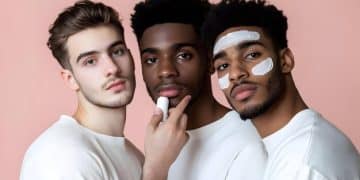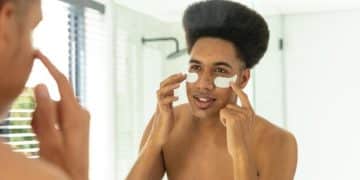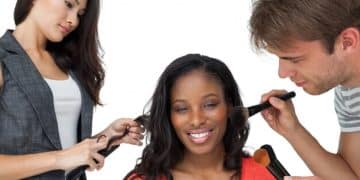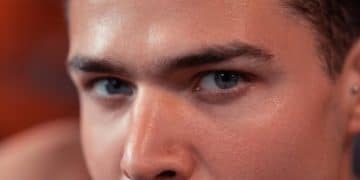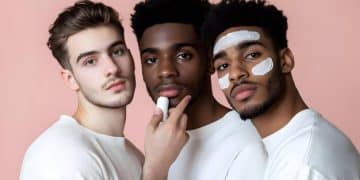Future of Men’s Makeup: Innovations by 2030 in US
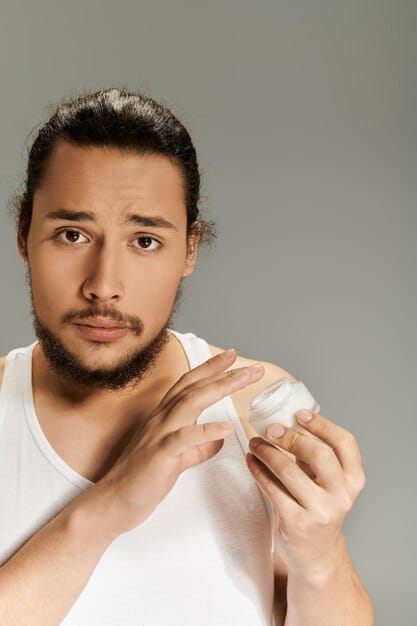
By 2030, the US men’s makeup market is poised for significant growth, driven by innovations in custom formulations, sustainable practices, AI-powered personalization, and specialized skincare-infused cosmetics, reflecting broader shifts in masculinity and self-expression.
The landscape of grooming and self-expression for men is undergoing a profound transformation. What was once a niche market is rapidly expanding, bringing men’s makeup from the fringes into mainstream consciousness. This evolution isn’t merely about superficial aesthetics; it reflects deeper societal shifts in gender norms, self-care, and personal freedom. As we look towards 2030, the question isn’t whether men will embrace cosmetics, but rather, what groundbreaking innovations will define this burgeoning industry in the US?
The evolving perception of masculinity and beauty
The traditional definitions of masculinity, once rigid and unyielding, are steadily giving way to more fluid and inclusive interpretations. This cultural shift directly impacts industries like beauty and personal care, where products historically segmented by gender are now experiencing a convergence. Societal expectations are broadening, allowing men greater freedom in how they present themselves to the world, and this includes an increased openness towards cosmetics.
This isn’t a sudden phenomenon but a gradual evolution, supported by media representation and advocacy from influential figures. Celebrities, influencers, and even everyday individuals are challenging stereotypes, showcasing how grooming practices, including makeup, can be an integral part of self-care and personal style, rather than solely a tool for performance or disguise. The narrative is shifting from “correcting imperfections” to “enhancing natural features” and expressing individuality.
Redefining self-care and personal expression
- Beyond basic grooming: Men are increasingly viewing their grooming routines as opportunities for self-care and mindfulness, moving beyond simple hygiene to embrace more sophisticated product offerings.
- Influencer impact: Social media platforms have become powerful catalysts, with male beauty influencers normalizing and celebrating men’s makeup, making it more accessible and less intimidating.
- Breaking down barriers: Younger generations, particularly Gen Z, demonstrate a significantly higher acceptance of gender-fluid beauty standards, viewing makeup as a form of artistic expression for all, regardless of gender.
The dialogue around men’s beauty is also becoming more nuanced. It acknowledges that men, like women, face skin concerns such as acne, redness, dark circles, and uneven tone. Makeup is emerging as a practical solution for these issues, rather than just an aesthetic adornment. This pragmatic approach resonates with a demographic seeking effective, straightforward solutions for skin health and appearance, blurring the lines between skincare and cosmetic coverage.
As these perceptions continue to evolve, the market is responding with products tailored to men’s specific needs and preferences. This foundational shift in cultural mindset is the fertile ground upon which the future innovations of men’s makeup will flourish, laying the groundwork for a truly inclusive beauty industry by 2030.
Customization and personalization: the rise of bespoke beauty
In the expansive and increasingly sophisticated world of beauty, the era of “one-size-fits-all” products is rapidly fading, particularly within the nascent yet dynamic men’s makeup sector. By 2030, personalization will not just be a luxury; it will be an expectation, fundamentally redefining how men interact with cosmetic products in the US. This impending wave of customization promises formulations that are precisely calibrated to individual skin tones, types, and concerns, moving far beyond current offerings.
Imagine a future where your foundation isn’t merely chosen from a limited palette, but created on demand, matched exactly to your unique skin undertones detected by advanced AI. This level of precision extends to ingredients, where formulations can be adjusted to exclude specific irritants or enhance properties beneficial for individual skin conditions, such as reducing oiliness or boosting hydration. The emphasis shifts from merely “covering” to “treating and enhancing,” merging the boundaries between skin care and makeup with unprecedented specificity.
AI-driven diagnostics and bespoke formulations
- At-home skin scanning: Expect integrated smartphone apps or compact personal devices that can perform detailed skin analyses, identifying imperfections, tone variations, and hydration levels.
- Algorithmic recommendations: AI will leverage these scans to recommend precise product formulations, from tinted moisturizers to concealers, ensuring unparalleled shade matching and ingredient efficacy.
- On-demand manufacturing: Micro-factories or even in-store kiosks could fabricate custom makeup blends in real-time, reducing waste and ensuring fresh, potent products.
The journey towards bespoke beauty will also involve consumer-led preferences. Men will have the power to select desired finishes—matte, natural, or subtle glow—and even modify texture preferences, such as a lighter feel for daily wear or more robust coverage for specific events. This level of granular control empowers the user, transforming the act of purchasing makeup from a search for “the closest match” into an experience of co-creation.
Furthermore, this hyper-personalization extends to scent preferences and packaging design, catering to individual aesthetic and sensory desires. Brands will leverage vast data sets, compiled from individual user profiles and aggregate trend analyses, to continuously refine their customization algorithms, ensuring that the bespoke products not only meet current needs but anticipate future preferences. This evolution means that by 2030, the act of applying makeup will be an intimately personalized ritual, yielding results that feel inherently “right” because they were made specifically for you.
Sustainable and ethical practices: the conscientious consumer
As awareness of environmental impact and ethical sourcing continues to grow, the conscientious consumer is becoming a major driving force across all industries, and men’s makeup is no exception. By 2030, sustainability and ethical practices will move from being optional brand features to non-negotiable standards within the US market. This shift reflects a broader societal commitment to environmental stewardship and social responsibility, influencing everything from ingredient sourcing to packaging design and manufacturing processes.
Brands will increasingly integrate robust sustainability frameworks into their core operations, not just as marketing ploys but as fundamental principles. This includes a resolute move towards formulations with minimal ecological footprints, favoring naturally derived, biodegradable ingredients over synthetic ones. The concept of “clean beauty” will evolve further, encompassing not only the absence of harmful chemicals but also the presence of ethically sourced components and transparent supply chains, ensuring fair labor practices and responsible resource management.
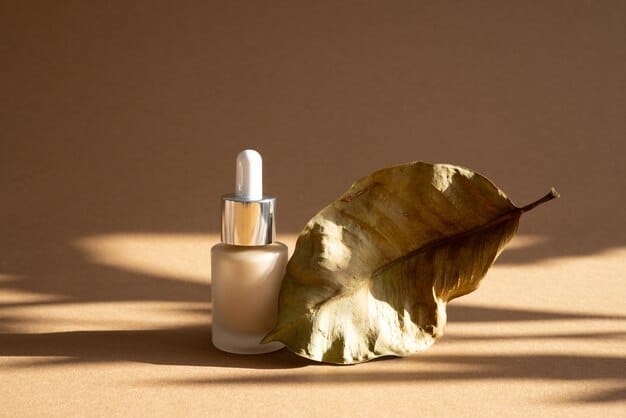
Eco-friendly formulations and circular packaging
- Biodegradable ingredients: Development of makeup components that break down naturally post-use, preventing microplastic pollution and reducing environmental burden.
- Waterless formulations: Concentrated, anhydrous products will gain traction, reducing the need for preservatives and minimizing shipping weight/carbon footprint.
- Refillable packaging systems: Mainstream adoption of sleek, durable, and easily refillable containers, drastically cutting down on single-use plastic waste.
Beyond the product itself, the entire lifecycle will come under scrutiny. Manufacturers will prioritize energy-efficient production methods, utilizing renewable energy sources and minimizing water consumption. Waste reduction will be paramount, extending to supply chain logistics and end-of-life considerations for products and packaging. The circular economy model—where materials are kept in use for as long as possible—will become a blueprint for industry practices, moving away from the linear “take-make-dispose” approach.
Traceability will also be a key differentiator. Consumers will demand transparent information about where ingredients come from, how they are harvested, and the conditions under which products are manufactured. Blockchain technology could play a role in verifying ethical sourcing and supply chain integrity. Brands that genuinely commit to these principles will build stronger trust and loyalty with a growing segment of environmentally and socially conscious male consumers, positioning themselves as leaders in a future where ethical responsibility is as valued as product performance.
Skincare-makeup hybrids: fusion for functionality
The line between skincare and makeup is becoming increasingly blurred, and by 2030, this integration will reach new heights within the men’s beauty market in the US. The concept of “skincare-makeup hybrids” will evolve beyond simple SPF additions into sophisticated formulations that actively improve skin health while providing cosmetic benefits. Men, generally appreciating efficiency and multi-purpose products, will gravitate towards these hybrids that offer a streamlined routine without compromising on results.
These innovative products will feature active skincare ingredients at effective concentrations, designed to address common male skin concerns simultaneously with providing subtle coverage or enhancement. Think of tinted serums infused with potent antioxidants and hyaluronic acid, or concealers fortified with salicylic acid to treat blemishes while camouflaging them. The appeal lies in products that not only make the skin look good instantly but also contribute to its long-term health and vitality, embodying a holistic approach to grooming.
This trend is driven by a consumer base that is increasingly educated about dermatological science and seeks real, measurable benefits from their beauty purchases. Products will be formulated to target issues such as oil control, anti-aging, redness reduction, and environmental protection, making them integral components of a comprehensive skincare regimen rather than mere cosmetic add-ons. The language around these products will shift, focusing on their therapeutic properties as much as their aesthetic ones, resonating with a pragmatic male audience.
Advanced active ingredients and smart delivery systems
- Peptide-infused foundations: Products that promote collagen production and improve skin elasticity over time, offering anti-aging benefits alongside light coverage.
- Niacinamide-rich tint: Formulations that help regulate sebum production, reduce pore appearance, and calm inflammation, ideal for oily or acne-prone skin.
- Encapsulated actives: Smart delivery systems that ensure stability and optimal absorption of sensitive ingredients like Vitamin C or retinol, releasing them effectively into the skin throughout the day.
The convenience factor of these hybrids cannot be overstated. For men seeking efficient routines, a single product that can hydrate, protect, even out skin tone, and address specific concerns is incredibly appealing. This fusion extends to texture and wearability, with innovations focusing on lightweight, non-greasy formulas that feel comfortable and look natural, seamlessly integrating into daily life without feeling heavy or obvious. By 2030, these intelligent skincare-makeup hybrids will likely form the cornerstone of many men’s grooming repertoires, representing the ultimate synergy of efficiency and efficacy.
Inclusive shades and diverse product ranges
For too long, the beauty industry has grappled with the challenge of true inclusivity, particularly concerning shade ranges and product diversity tailored to a broad spectrum of skin tones and types. By 2030, the men’s makeup market in the US will be characterized by an unwavering commitment to this inclusivity, moving beyond token offerings to provide truly comprehensive and diverse product lines. This evolution is vital to serving an increasingly globalized and multifaceted consumer base, where one-size-fits-all beauty solutions are simply inadequate.
The expansion of shade ranges will be a primary focus, ensuring that every individual, regardless of their ethnicity or complexion, can find a perfect match for foundations, concealers, and tinted moisturizers. This involves not only increasing the sheer number of shades but also understanding the nuances of undertones—cool, warm, and neutral—to provide truly seamless blending and natural-looking results. Brands that excel in this area will gain significant loyalty from consumers who have historically felt underserved and overlooked by traditional beauty offerings.
Beyond just foundations, diversity will extend to a wider array of cosmetic products tailored for men’s specific needs and preferences. This might include brow gels designed for coarser hair, subtle bronzers that enhance natural contours without looking heavy, or even color correctors that address specific concerns like hyperpigmentation on darker skin tones, or redness on lighter complexions. The market will recognize that men’s skin, while sharing commonalities, also has distinct characteristics and concerns that warrant specialized formulations.
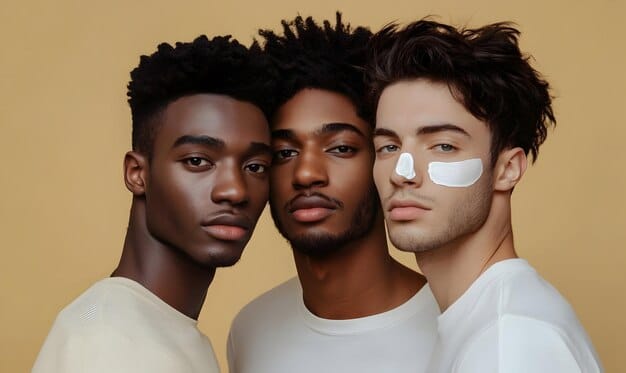
Tailored solutions for every skin story
- Expansive undertone mapping: Utilizing advanced technology to define an unprecedented number of undertones, ensuring a truly custom match for every complexion.
- Targeted product development: Creating products that address specific male skin characteristics, such as oiliness in the T-zone, or uneven facial hair growth patterns.
- Culturally relevant offerings: Developing products that resonate with diverse cultural practices and aesthetic preferences, ensuring global appeal and local relevance for men across the US.
Marketing and representation will also play a crucial role in fostering true inclusivity. Campaigns will feature men of all ages, backgrounds, and skin tones, showcasing the versatility and universal appeal of men’s makeup. This visual representation is critical for normalizing usage and demonstrating that these products are for everyone. Brands that genuinely embrace and celebrate this diversity will not only expand their market reach but also build a reputation for authenticity and social responsibility, paving the way for a beauty industry that truly reflects its global audience by 2030.
Technological integration: smart beauty solutions
Looking ahead to 2030, the integration of technology will transform men’s makeup from a mere product application into an interactive, data-driven experience within the US. This “smart beauty” revolution goes beyond simple online recommendations, delving into AI-powered diagnostics, augmented reality (AR) try-ons, and personalized product delivery systems. The goal is to make the entire beauty journey, from discovery to application, more efficient, precise, and genuinely engaging for male consumers, who often value utility and innovation.
Augmented reality (AR) will become a staple, moving beyond novelty to offer highly accurate virtual try-ons for everything from tinted moisturizers to brow defiers. Users will be able to see how different shades and products appear on their own skin in real-time, under various lighting conditions, minimizing guesswork and improving purchase confidence. This technology will leverage sophisticated facial mapping to ensure hyper-realistic simulations, revolutionizing the shopping experience both online and in-store.
Beyond AR, AI will play a critical role in personalized product curation. Imagine an AI assistant that analyzes your daily environmental exposure, lifestyle habits, and even sleep patterns to recommend specific product adjustments or application techniques for the day ahead. These intelligent systems could monitor changes in skin condition over time, dynamically suggesting tweaks to formulations or routines to optimize results. This predictive and responsive approach will elevate men’s grooming to an unprecedented level of precision and efficacy.
AI-powered application and connected devices
- Smart applicators: Devices that guide users on precise product amounts and application techniques, ensuring optimal coverage and benefit, especially for beginners.
- IoT-enabled product monitoring: Packaging with integrated sensors that track product usage, expiry dates, and even skin’s response to ingredients, providing valuable feedback for reordering.
- Personalized routines through apps: Mobile applications that consolidate skin analysis data, product history, and personal preferences to create evolving, tailored grooming schedules.
The emergence of “smart mirrors” or even integrated bathroom mirrors with built-in skin analysis capabilities will further enhance the technological integration. These mirrors could project virtual try-ons, highlight areas needing attention, and provide personalized grooming tips based on real-time skin diagnostics. This seamless integration of technology into daily routines will simplify and optimize men’s approach to makeup, making it an intuitive and indispensable part of their personal care regimen by 2030, driven by the desire for effective, futuristic solutions.
Education and destigmatization: fostering wider adoption
Despite the rapid advancements in product innovation and market acceptance, a significant hurdle for the widespread adoption of men’s makeup in the US by 2030 remains: education and destigmatization. While progress has been made, lingering societal biases and lack of clear guidance continue to deter many men from exploring cosmetics. The future growth of this market hinges on comprehensive educational initiatives and a concerted effort to dismantle existing stereotypes.
Education will not merely involve teaching application techniques but will encompass a broader understanding of skin health, product ingredients, and the benefits of makeup beyond superficiality. Workshops, online tutorials, and in-store consultations—specifically curated for men—will become commonplace, offering safe and approachable environments for learning. The focus will be on practical, easy-to-understand guidance, emphasizing how makeup can address common concerns like dark circles, razor burn, or uneven skin tone in a natural, undetectable way.
Crucially, destigmatization requires a sustained cultural conversation that redefines what it means for men to engage with beauty products. This involves celebrating diverse expressions of masculinity and promoting the idea that self-care and aesthetic enhancement are universal human desires, not bound by gender. Media representation will be key, showcasing men from all walks of life—athletes, businessmen, artists—using makeup as a tool for confidence, professionalism, or personal enjoyment, without attaching it to specific sexual orientations or subcultures.
Empowering men through informed choices
- Inclusive marketing campaigns: Featuring a wide array of male archetypes and showcasing how makeup enhances their authentic selves, avoiding sensationalism.
- Dermatologist-led initiatives: Collaborations with dermatologists and skincare experts to validate the health benefits of certain makeup products, lending credibility and fostering trust.
- Peer-to-peer advocacy: Encouraging open discussions among men about their grooming routines, fostering a community that supports men exploring cosmetics without judgment.
Furthermore, product branding and naming conventions will adapt to be more gender-neutral or explicitly masculine, using language and imagery that resonates with male consumers without alienation. Packaging will be designed to be sleek, minimalist, and discreet, reflecting practical aesthetics. By addressing the fundamental issues of education and societal perception head-on, the men’s makeup market can truly unlock its full potential, creating a future where cosmetics are seen as a natural and accepted extension of self-care for all men in the US by 2030, fostering greater confidence and self-expression across the board.
| Key Innovation | Brief Description |
|---|---|
| ✨ Customization | AI-driven formulations tailored to individual skin needs and preferences. |
| 🌎 Sustainability | Eco-friendly ingredients, refillable packaging, and transparent ethical sourcing. |
| 🧪 Skincare Hybrids | Makeup infused with active skincare ingredients for dual benefits. |
| 💡 Tech Integration | AR virtual try-ons, smart applicators, and AI-powered personalized routines. |
Frequently Asked Questions about Men’s Makeup by 2030
Yes, significant trends indicate men’s makeup will move further into the mainstream by 2030. Driven by evolving perceptions of masculinity, celebrity influence, and increased openness among younger generations, cosmetics for men are becoming more normalized as a tool for self-expression and practical grooming. Products designed with men’s specific needs in mind will facilitate wider acceptance and adoption across various demographics.
By 2030, expect a surge in personalized, skincare-infused hybrid formulations. Innovations will include AI-driven customization for perfect shade matching, active ingredients targeting specific male skin concerns like oiliness or sensitivities, and sustainable, clean formulations using naturally derived components. Products will aim for a natural, undetectable finish while enhancing skin health over time, blending beauty and wellness seamlessly.
Technology will revolutionize the men’s makeup experience. Augmented reality (AR) will enable hyper-realistic virtual try-ons, making product selection easier. AI-powered diagnostics will offer precise skin analysis and personalized product recommendations. Smart applicators and IoT-enabled devices could provide guided application and track product efficacy, leading to highly customized and efficient grooming routines for men by 2030.
Absolutely. Sustainability will be a paramount consideration. Consumers will increasingly demand eco-friendly formulations, transparent ethical sourcing, and refillable or recyclable packaging. Brands will focus on biodegradable ingredients, waterless products, and energy-efficient manufacturing processes to appeal to the environmentally conscious male consumer. This commitment to sustainability will be a major differentiator in the market by 2030.
Education is crucial for wider adoption. Brands will need to provide clear, accessible guidance on product benefits, application techniques, and how makeup can enhance natural features discreetly. Destigmatization efforts through inclusive marketing campaigns and open dialogue will also normalize men’s makeup, moving it beyond niche appeal and showcasing it as a legitimate aspect of modern male self-care and self-expression, fostering confidence in myriad ways.
Conclusion
The Future of Men’s Makeup: What Innovations Can We Expect to See by 2030 in the US? is not just a question of product development, but a reflection of broader societal evolution. By 2030, the US market will be characterized by hyper-personalization driven by AI, a profound commitment to sustainability, and the seamless fusion of skincare and cosmetics into highly effective hybrid formulas. Beyond these tangible innovations, the critical shifts in perception—fostering inclusivity, breaking down stigmas, and promoting education—will ultimately determine the widespread adoption of men’s makeup. This evolving landscape points towards a future where self-care and self-expression through grooming are truly universal, accessible, and celebrated across all genders, marking a new era of beauty defined by utility, ethics, and individuality.

